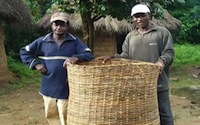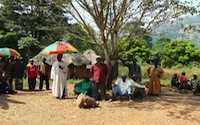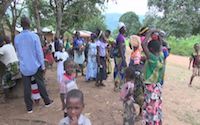Bezen, a hitherto completely undescribed Jukunoid language of the Yukuben-Kuteb subgroup, is spoken by approximately 450 individuals (Ethnologue 2009) in the remote village of Bezen (formerly: Kpwep) in the Furu-Awa Subdivision of the North-West Region of Cameroon.
Classification
Apart from Brye’s “Rapid Appraisal” (2004) which contains 120 lexical items and a sociolinguistic survey and exploratory elicitations conducted by Roland Kießling, Jeff Good, Scott Farrar and Cristin Kalinowski in 2007, Bezen remains virtually unknown.
Given this lack of descriptive data, its classificatory position within Benue-Congo remains controversial. While Gordon 2005 lists Bezen as unclassified, Breton & Fohtung 1991 assign it to the Jukunoid language group, and Lewis 2009 lists it as belonging to the Yukuben-Kuteb subgroup within Jukunoid. According to present findings, Bezen seems quite detached both from neighbouring Akum and from Jukun proper. Even though lexical and grammatical data seem to confirm its closer affiliation to Jukun, it remains to be worked out how close the link actually is and – more important still – if it results from a genetic relationship or from extensive language contact induced by long-standing bilingualism of the Bezen population in Jukun prevailing in the area.
Phonology
Bezen phonology exhibits various features typical of Benue-Congo languages in the area of the Cameroon-Nigerian borderland. Consonant phonemes come in four subsystems: unmodified consonants, labialized stops, palatalized consonants and prenasalised stops. Among the unmodified consonants a set of labiovelars (kp, gb, ŋm) is the most striking phenomenon.
(1) Unmodified consonant phonemes
| labial | alveolar | palatal | velar | labiovelar | glottal | |
| Plosives: | p b | t d | k g | kp gb | ||
| Nasals: | m | n | ɲ | ŋ | ŋm | |
| Affricates: | ts | |||||
| Fricatives: | f | s z | h | |||
| Trill: | r | |||||
| Lateral: | l | |||||
| Approximants: | j | w |
While labialisation is restricted to three phonemes, i.e. /bw/, /kw/, /gw/, and prenasalisation only occurs with voiced stops, i.e. /mb/, /nd/, /ɲɟ/, /ŋg/, palatalization is attested with most of the unmodified consonants except /gb/, /l/, /j/, /w/, /n/, /ɲ/, /ŋ/ and /ŋm/.
Among the six vowel phonemes – /i, e, ɨ, a, o, u/ – the central vowel /ɨ/ stands out as having a wide range of allophonic realisations.
Three contrastive level tones distinguish grammatical as well as lexical meanings, e.g. hú ‘die’ (high level tone) vs. hū ‘gather’ (mid level tone) vs. hù ‘fall’ (low level tone); kɨ́b ‘chew’ vs. kɨ̄b ‘add’ vs. kɨ̀b ‘cover’. In the grammatical domain, the central contrast of centrifugal vs. centripetal action relies on a tonal contrast exclusively.
On the phonotactic level, these segmental and suprasegmental units combine to form the following canonical syllable structures: V, VC, CV, CVC. Processes such as coda reduction and intervocalic lenition determine the phonetic realisation of voiced plosives, while various types of vowel assimilation affect the compatibility of vowel phonemes.
Major morphosyntactic features
Basic word order in unmarked clauses is S V O, while in nominal phrases modifiers generally follow their head.
In morphology, the pre-existing Benue-Congo noun class system has largely disappeared and left its traces in a complex system of deverbal nominal derivation and nominal number marking by prefix alternations. The agreement system is reduced to a contrast of animate vs. inanimate.
Verbs are inflected for various tenses, aspects and moods by an interaction of proclitics, enclitics and changes in tonal patterns. Some markers of grammatical categories could be traced back to their lexical sources, e.g. the perfect enclitic mɨ́ and the habitual proclitic ŋɨ̄ are transparently derived from verbs meaning ‘finish’ and ‘sit, stay’, respectively. Future research will shed more light on prominent phenomena in syntax such as verbal serialisation and intensification of intransitive verbs by cognate complement constructions such as dō mbūr ùmbùr mɨ́ ‘we are very tired’ (literally: “we have tired tiredness”).
References
Breton, Roland, Bikia Fohtung. 1991. Atlas Administratif des langues nationales du Cameroun. Yaoundé and Paris: CERDOTOALA, ACCT.
Brye, Edward. 2004. A Rapid Appraisal of Beezen. Ms. SIL International, 15pp.
Gordon, Raymond G. Jr. 2005. Ethnologue: Languages of the World, 15th edition. Dallas: SIL International.
Lewis, M. Paul (ed.). 2009. Ethnologue: Languages of the World, 16th edition. Dallas: SIL International. Online version: http://www.ethnologue.com/.







